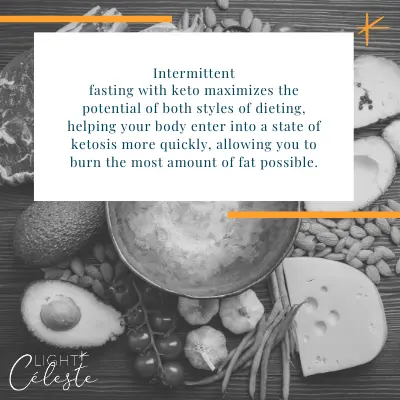Ketosis with intermittent fasting has become a very trendy, health-focused weight-loss method in recent years, and for good reason.
The Ketogenic Diet has been neck and neck in popularity with fasting for nearly a decade now. It makes sense to pair the two similar methods to get one highly efficient protocol for safe, significant weight loss.
This article will take a close look at the benefits of fasting with and without ketosis, as well as highlight some symptoms of fasting success.
Ketogenic and Intermittent Fasting
Intermittent fasting is a cycle of eating that leaves a window of 12+ hours in which you don’t eat. Some people aim for 12 – 16 hours of fasting a day whereas others prefer 24 hours of fasting every other day. There are many other fasting protocols you can follow to suit your needs as well.
Ketosis is a metabolic state in which your body uses fat as fuel for regular operations rather than carbohydrates. You will enter this state whenever your body runs out of easily accessible carbs. As you can imagine, this happens fairly quickly when you stop eating. To keep all systems running, your body is designed to start to burn the fat that has been stored for just such an occasion.
The ketogenic diet also puts your metabolism into a state of ketosis simply by restricting the number of carbs eaten to an extremely low amount. Instead, when you follow this diet, you provide your body with plenty of fat to use as fuel, adapting it to this type of energy.
Intermittent Fasting with Keto
Intermittent fasting with keto maximizes the potential of both styles of dieting. Your body enters into a state of ketosis more quickly, allowing you to burn the most amount of fat possible.
The keto diet is very effective at encouraging weight loss, there is no doubt about that. But it is not a diet that is focused on nutrition. It can be followed healthfully, and for many people, losing a significant amount of weight alone is certainly a healthy progression. For long-term benefits, it can have health consequences if serious attention is not paid to micronutrition.
Most fruits, vegetables, and other plant matter that are extremely high in vital minerals, vitamins, and antioxidants are considered carbs. For best results, while following a ketogenic diet, maximize your intake of low-carb, nutrient-dense plants like leafy green vegetables. Combining the keto diet with fasting can offset any occasional carb highs with the ketosis inducing benefits of time-restricted eating.

Intermittent Fasting Without Keto
You can very effectively practice intermittent fasting without following the ketogenic diet, but the health and weight loss benefits will still show more significantly if you fast long enough to induce a state of ketosis.
It’s important to distinguish here between ketosis and the ketogenic diet. Ketosis is a metabolic state whereas the Keto diet was designed to allow your body to be in a state of ketosis without going through the natural feast and famine cycle that has followed humans throughout history.
You don’t have to fast to enter ketosis. You also don’t have to follow the ketogenic diet to enter ketosis.
By practicing intermittent fasting for a minimum of 12 hours, your body will naturally enter into the fat-burning state of ketosis. When you’re not fasting, you can enjoy all your favorite healthy foods, including carb and nutrient-rich plants and vegetables, knowing your weight and health goals are still intact.
Fasting Ketosis Symptoms
Whether you’re pairing the ketogenic diet with your fasting or you’re aiming to hit a state of ketosis with intermittent fasting alone, you’ll need to learn what signs and symptoms to look for to show that you’ve reached your goal.
The most reliable way is to directly measure your blood for ketones. There are keto strips that test for ketones in a similar way to measuring blood sugar levels. If you’re not quite ready to resort to bloodletting, there are less invasive ways to monitor for ketones.
Ketosis symptoms:
- Fruity breath. This is one of the most common signs that you’re in a deep state of ketosis. It’s caused by elevated ketones in your blood, specifically acetone. It may not be overly pleasant, but in moderation, it’s a good sign for your diet.
- Hyperfocus and energy. Fat is a very effective fuel for your body and your brain, in particular. Your brain will be on full alert in part due to the extra fat being supplied as food, but also as your body’s natural response to a state of famine. Your senses will increase to give you a better chance of success hunting and/or gathering food.
- Digestive distress. Whenever you dramatically alter your eating habits, your digestive system is going to need to adapt. This should resolve itself the more often you put your body into a state of ketosis, but it isn’t unusual to experience some constipation or diarrhea at first.
- Poor sleep. Carbohydrates help your body follow a natural circadian rhythm and, when you’re not eating any, it can affect your sleep. Again, as your body adapts to the state of ketosis, this should resolve itself. For the first few days or even weeks of a new diet routine, be gentle with your body if you’re sleeping is being interrupted.
- Weight loss! This is the ultimate goal for most people and it’s a really good sign that you’re regularly and successfully entering ketosis and your body is burning through reserved stores of fat. Congratulations!
Keto and Intermittent Fasting Success
Some people turn to the Ketogenic diet or Intermittent Fasting as an excuse to eat all the fatty, fried, junk foods they’re addicted to and feel justified in their health efforts. Please understand that, even if you’re burning fat in a state of ketosis, you still need to have a care for your health beyond your weight. Your heart, brain, and other vitals organs thrive on nutrition. Make sure what you’re eating when you’re eating is packed with the vitamins and minerals that are not only going to keep you slim, but also energetic and vibrant.



